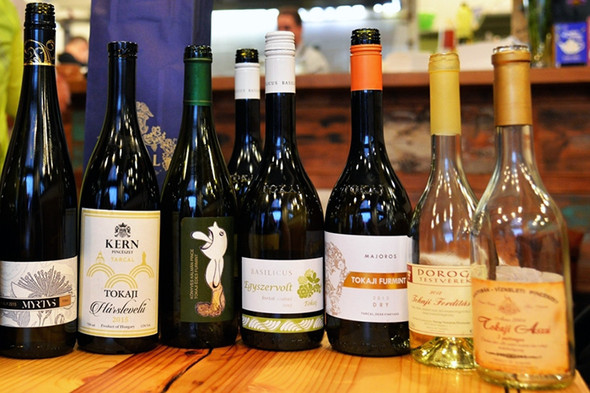Many visitors may sleep in the town of Tarcal thanks to two of the Tokaj wine region’s premier hotels (the five-star Andrássy Rezidencia Wine & Spa and the four-star Gróf Degenfeld Castle Hotel) being located there, but Tarcal is often overlooked when it comes to the wine itself – and for no good reason. While visitors may often check in and then head straight off to Mád or Tokaj town or get no further than the very good Degenfeld winery, a recently formed organisation known as the Tarcal Kulturális Egyesület (Tarcal Cultural Association), with some of the town’s finest winemakers in its number, is hoping to put Tarcal more firmly on the vinous map.
Those in the know have long valued Tarcal and its loess-based soil’s elegant, smooth and fruity take on the Tokaj tale, which presents a welcome alternative and sometimes stark contrast to the often edgier, sharper style from the pure volcanic cocktail of soils from Mád. There’s much more to Tarcal than loess however, and below it, at varying depths, lies pure volcanic dacite or andesite bedrock. Incidentally, Tarcal’s 650 hectares of area under vine amounts to some 10% of the Tokaj region’s total. Tarcal also claims Tokaj’s oldest vineyard, Szentkereszt-dűlő, which is believed to have first been planted around a thousand years ago. It also possesses many of the region’s warmest sites thanks to it being at the southernmost point of the region, which ensures ripe grapes and even brings a tropical touch to some of the wines in warmer years – quite something in a cooler climate wine region like Tokaj. The town is also home to the Tarcal Research Institute, a hotbed of vinous innovation in the region, where the crossings Kabar a.k.a. Tarcal 10 (Bouvier x Hárslevelű) and Zéta (Bouvier x Furmint) came into being.

Plans for the Tarcal Kulturális Egyesület, which was formed last autumn and is currently chaired by French winemaker Stéphanie Berecz of the Kikelet Winery, include a joint Tarcal wine and regular events. Happenings include Tarcal Akusztik – on June 11, July 9 and August 13 – which fuses wine, food, culture and you guessed it – acoustic music! Members of the Tarcal Kulturális Egyesület hit the capital at the beginning of June for a wine tasting at the stylish Franco-Vietnamese Situ restaurant in the heart of buzzing District VII and presented the following wines:
Dry wines
Majoros Birtok, Tokaji Muscat Blanc 2015 I 87-89 points
This dry Sárgamuskotály has excellent varietal character with peach, orange blossom and grape soda notes. Light, floral, pure and clean as a whistle, and also has great drinkability. A big step in the right (fresh and vibrant) direction for the winery.
Kikelet Pince, Tokaji Pezsgő Brut 2013 I 86-88 points
Traditional method sparkling wine from 100% Hárslevelű, hailing from 45-year-old vines from the Lónyai and Kassai vineyards. Pineapple, lime, fairly intense bubbles, quince and pear aromas. Lime peel rather than yeastiness on the palate but there’s a touch of bread crust. Nice weight and fruit on the creamy palate. So you can make traditional method sparkling wine out of Hárslevelű– or at least ‘Hárs Queen’ Stéphanie Berecz can. (Kreinbacher in Somló decided against using the grape in its traditional method sparklers.)
Myrtus Pince, Muskotály száráz 2015 I 86-89 points
Floral and grapey, clean and vibrant aromas, with sufficient acidity on the palate to make it vibrant. A nice example of Sárgamuskotály in what appears to be a stellar vintage for the grape (although I did hear that there was some sunburn on the Sárgamuskotály grapes in some parts of the region).
Kern Pince, Hárslevelű 2015 I 82-84 points
Creaminess, quince and oak – lots of it and a bit too much in fact. A little less would have enabled the no doubt rich fruit to come through better. Nevertheless, this is a decent early effort from Russian winemaker Jelena Szavercsenko, a former professional basketball player who settled in Hungary after playing here.
Volt Császári Birtokközpont és Pince, Furmint 2014 I 78-80 points
A little on the rustic and vegetal side with lots of sweet pear – it actually feels quite sweet and is hard to believe it’s actually a dry wine. Slightly out of balance.
Majoros Birtok, Tokaji Deák Furmint 2013 I 89-91 points
From the warmest site in the region with suitable tropical notes of mango and pineapple on the nose and palate. The high acidity of 2013 allows this wine with 8g/l residual sugar to still be released as a dry wine. Long, rich and creamy.
Basilicus, Egyszervolt Cuvée 2012 I 90-92 points
A blend of Furmint, Harslevelu and Sárgamuskotály fermented and aged in barrels. Intense yet elegant with lime, lemon grass, vegetal touches and a nutty finish. Balanced, round and very complex. Compelling evidence that the main Tokaj grapes can also work together to dramatic effect in dry wine.
Sweet wines
Volt Császári Birtokközpont és Pince, Furmint 2014 I 79-81 points
Promising lime and Williams pear aromas, although not a lot extra going on the medium-bodied palate.
Dorogi Testvérek Pince, Tokaji Forditás 2012 I 86-88 points
Very rich, exotic and promising on the nose with honey, mango, pear, yet thinner than aszú and less elegant on the palate (as the ‘sloppy seconds’ of aszú berries often are) but still quite citrusy and fresh.
Matyisák – Vizkeleti Pincészet, 5 puttonyos aszú 2004 I 82-84 points
Very deep amber colour, old school style, dark and nutty aszú, but with some zesty orange peel.
Tokajicum Borház, Tokaji Mandulás Aszú 6 puttonyos 2010 I 79-81 points
Intense aromas and flavours of coffee, ginger, raisins and dates, but far too mature and oxidised for a six-year-old wine with a deep amber colour.






